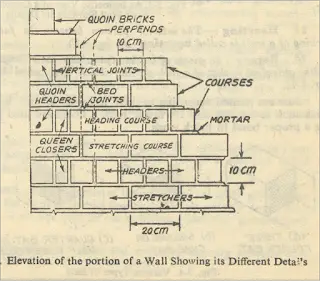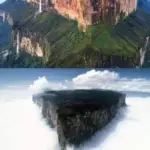Bricks are of uniform size and shape, light in weight, durable, fire resistant, have high resale value, low maintenance cost and are easily available in plain areas.
Brick Masonry is commonly used for construction of ordinary as well as important buildings in plain areas now-a-days.
(1) BRICK
An artificial structural element in the form of a rectangular block of clay is called a “Brick \”. Bricks can be manufactured of any required shape and size.
 |
| Bricks |
The sizes of some standard bricks are given as follows:
These sizes are called \”Nominal, designated or format sizes\” and are used while estimating the number of bricks in a given volume of structure.
Like Us on Facebook!
The actual sizes in which bricks are manufactured, are slightly smaller to allow for the layer of mortar present all around the brick, usually taken as 3/8 in thick.
Subscribe Us on YouTube!
The Actual or Work size of English standard brick, which is mostly used in Pakistan, is usually taken as 8 5/8 in 4 1/8 in x 2 5/8 in.
(2) FROG
The depression provided in the face of a brick is called a \”Frog\”.
It is provided in the brick to achieve the following purposes:
• To form a key of mortar in between any two adjacent courses of brick work, so as to increase the lateral strength of the structure.
• To reduce the weight of the bricks, so that the bricks can be laid with convenience.
• To provide a place for putting the impression of trade-mark or the year of manufacturing of the bricks.
(3) POSITION OF BRICKS
(a) The position of brick, when laid with its Frog upward in the horizontal plane, is termed as \”Brick on bed\”.
(b) The position of the brick when laid on its side \”9 in x 3 in\”, with frog in the vertical plane is called \”Brick on edge\”.
(c) The position of brick when laid on its side \”4 1/2 in x 3 in\”, with frog in the vertical plane is called \” Brick on end\”.
(4) COURSE
Each horizontal layer of bricks laid in mortar in a brick work is called a \”course\”.
(5) STRETCHER
Brick, laid with its length horizontal and parallel with the face of the wall or other masonry member is called a \”Stretcher\” and a course, in which, all the bricks are laid as Stretchers is called a “Stretching course\” or \”Stretcher course\”.
(6) HEADER
A brick laid, so that only its end shows on the face of a wall is called a \”Header\” and a course, in which all the bricks are laid as headers, is known as \”Heading Course\” or \”Header course\”.
(7) QUOIN
The external corner of the wall is called a \”Quoin\”.
(8) QUOIN BRICK
The brick, which forms the external corner of a wall is known as \” Quoin brick\”.
(9) QUOIN HEADER
A corner header, in the face of wall, which is a stretcher in the side wall is known as \”Quoin header\”.
(10) QUOIN STRETCHER
A corner stretcher in the face of a wall, which is header in the side wall is known as \”Quoin stretcher\”.
(11) BRICK BATS
The pieces of bricks, cut long their length and having width equivalent to that of a full or half brick are called \”Brick bats“.
Some common Brick Bats are shown below:
(12) QUEEN CLOSER
Queen closer is a brick, which is half as wide as full brick and is made by cutting a whole brick lengthwise into two portions.
These are generally used next to the Quoin header for creating bonds in brickwork.
(13) KING CLOSER
A brick, whose one diagonal piece is cut off one corner by a vertical plane passing through the center of one end to the center of one side.
It is actually 7/8 of a full brick but is usually called a 3/4 brick
(14) BEVELED CLOSER
A brick cut longitudinally along a vertical plane, starting at the middle of one end to the far corner.
One quarter of the brick is cut off in this way.
(15) BULL NOSE BRICK
A brick with rounded corners is called a “Bull Nose Brick”
(16) SQUINT BRICKS
These bricks are used to construct acute (>90 degree) or obtuse (< 90 degree) corners in brick masonry.
These are special forms of bricks.
(17) JAMB
The vertical sides of door or window openings provided in a wall are known as \”Jambs\”.
(18) REVEALS
The part of the Jamb opening , which is exposed between a door or window frame and the face or back of a wall is known as \” Reveal\”.
(19) SILL
The horizontal part (either of timber, concrete, stone, metal, etc) at the bottom of a door or window, supporting the vertical members of the frame is known as \” Sill \” and its height window base from the floor level is known as \” Sill level \”
(20) MORTAR
• The paste obtained by mixing a binding material and a fine aggregate in suitable proportions in addition to water is known as \”Mortar\”.
• Cement and Lime are used as binding materials and Sand, Surkhi, Cinder, etc. are used as fine aggregates.
• The mortars are named according to the type of binding material used in their preparation such as, cement mortar, lime mortar, etc.
• The mortar prepared from simple earth is known as \”Mud Mortar\”.
• The mortar not only acts as a cementing bed between any two courses of bricks but also, gives strength to the structure by holding the individual bricks together to act as a homogenous mass.
Searches related to brick masonry
types of brick masonry
brick masonry pdf
brick masonry construction
brick masonry bonds
types of bonds in brick masonry
brick masonry specifications
brick masonry ppt
stone masonry
























